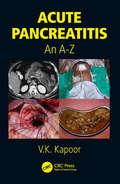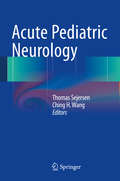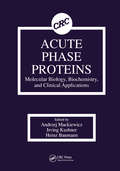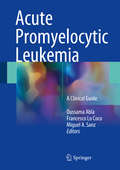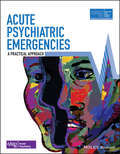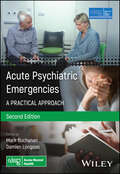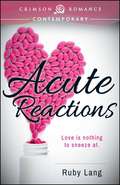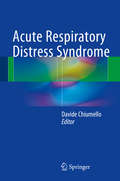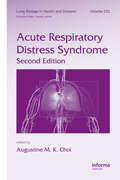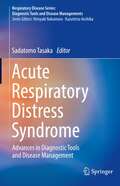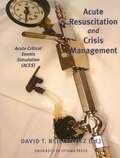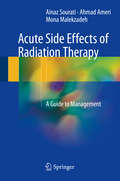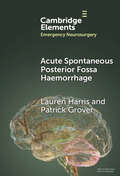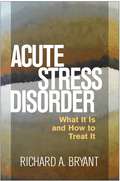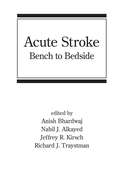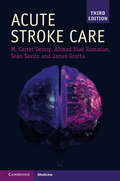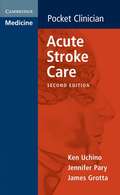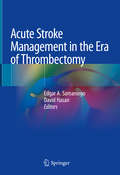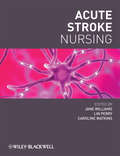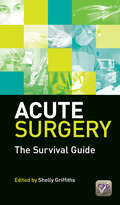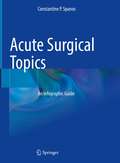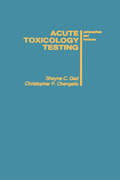- Table View
- List View
Acute Pancreatitis: An A-Z
by V.K. KapoorAcute pancreatitis is a common cause of acute abdomen. Diagnoses is difficult as the symptoms mimic that of many other medical and surgical conditions. Patients with severe acute pancreatitis can develop multiple organ failure and need intensive care. As its management is multi-disciplinary involving gastroenterologists, radiologists and surgeons, this book shall appeal to every doctor, irrespective of the specialty. This focused book conveys the knowledge of the basic concepts of acute pancreatitis in an innovative way. Original photographs and figures are used for the better understanding of the readers. In this pocketbook, various aspects related to acute pancreatitis are covered in a unique, simple and easy-to-read A-to-Z format and will be useful to medical students, post-graduate trainees and practicing doctors as a ready reckoner for pancreatitis. Key Features: • Innovative and unique A - Z format. • focuses on signal knowledge and fast clinical management of various facets of different types of acute pancreatitis. • Comprehensive approach with interesting facts. • Lucid and self-explanatory text. • Can be used as a ready reckoner pocketbook .
Acute Pediatric Neurology
by Thomas Sejersen Ching H. WangThis book provides recommendations for evaluation and therapy in the area of acute pediatric neurology; these are presented didactically with frequent use of illustrations and algorithms. Chapters in the first part of the book discuss presenting symptoms of acute neurological conditions. The second part of the book covers major areas of acute pediatric neurology and each of these chapters has three key elements: description of presenting symptoms; recommended assessments; and recommended interventions. Acute Pediatric Neurology provides an accessible, clinically focused guide to assist physicians in the emergency ward or intensive care unit in decisions on diagnosis and therapeutic interventions in all major acute pediatric neurological diseases.
Acute Phase Proteins Molecular Biology, Biochemistry, and Clinical Applications
by Irving Kushner Andrzej Mackiewicz Heinz BaumannAcute Phase Proteins covers all major aspects of acute phase proteins (APP) starting with molecular mechanisms regulating their synthesis and ending with their functional significance. The book features 36 chapters addressing such topics as acute phase response and the APP; major APP and their structure and functions; regulation of APP synthesis, the cytokines and hormones implicated in these processes, and molecular mechanisms involved; signal transduction of cytokines in hepatocytes and posttranscriptional processes; and quantitative and qualitative evaluation of APP in clinical practice. The book will be an important reference for immunologists, molecular biologists, cellular biologists, biochemists, and clinical chemists.
Acute Promyelocytic Leukemia: A Clinical Guide
by Oussama Abla Francesco Lo Coco Miguel A. SanzThis book provides a comprehensive overview on the clinical issues and biology of acute promyelocytic leukemia (APL) and on the molecular mechanisms of targeted therapy with ATRA and ATO. The text covers major topics such as the pathophysiology of APL coagulopathy, biologic and clinical differences between children and adults with APL, and the role of minimal residual disease monitoring. Additionally, the book summarizes historical, current, and future treatment strategies in both adults and children, while highlighting the most recent therapeutic recommendations for relapsed disease and the evolving indications for autologous and allogeneic stem cell transplant. This volume also features chapters focusing on secondary APL and therapy, late effects, rare presentations such as APL in the elderly and during pregnancy, and rare APL variants that may represent therapeutic challenges.
Acute Psychiatric Emergencies (Advanced Life Support Group)
by Advanced Life Support Group (ALSG)Acute Psychiatric Emergencies is designed for all medical and healthcare professionals working with patients in mental health crisis. This manual is a key component of the Acute Psychiatric Emergencies (APEx) course, which uses a structured approach developed by leading psychiatry and emergency medicine specialists with years of practical experience. This valuable resource provides a practical approach for dealing with mental health emergencies, helping healthcare professionals from different specialties speak a common language and develop a shared understanding that expedites excellent care. The manual outlines the assessment and management of patients who have self-harmed, those that are apparently drunk, the patient behaving strangely, the patient with acute confusion, and those that are aggressive. Presents a structured, practical approach for the emergency care of patients presenting in acute psychiatric crisis Covers common presentations of psychiatric emergencies Emphasises close co-operation of emergency and mental health teams Offers content designed jointly by practicing psychiatrists and emergency physicians from the Advanced Life Support Group (ALSG) Acute Psychiatric Emergencies will be useful for practitioners of emergency medicine, psychiatry, emergency and mental health nursing as well as other mental health and crisis care professionals.
Acute Psychiatric Emergencies: A Practical Approach (Advanced Life Support Group)
by Advanced Life Support Group (ALSG)An essential guide to the emergency treatment of mental health crises Hospital emergency departments are encountering increasing numbers of patients in mental health crises and the number continues to rise year on year. Despite these challenges, very few practitioners are trained specifically to deal with mental health crises. Acute Psychiatric Emergencies (APEx) meets this need with a course designed jointly by leading psychiatry and emergency medicine specialists with years of practical experience. It will help in any crisis setting be it in the emergency department, ward, clinic or in the community. APEx provides a structured approach for the assessment and management of acute mental health emergencies, discusses common presentations, as well as legal frameworks and human factors. Now fully updated to reflect new guidelines and expanded treatment of key subjects, it is an invaluable resource for any practitioner involved in the provision of psychiatric care at any point in the healthcare pathway. Readers of the second edition of Acute Psychiatric Emergencies will also find: Detailed discussion of topics including organic causes for behavioural disturbances, special circumstances and moreUpdated algorithms and figures for improved accessibilityAn emphasis on close cooperation between emergency and mental health teams APEx is ideal for emergency physicians, psychiatrists, emergency and mental health nurses, paramedics and other crisis care professionals. Advanced Life Support Group (ALSG) is an organisation dedicated to improving outcomes for people in life-threatening situations, anywhere along the healthcare pathway, anywhere in the world. A leading medical education charity, ALSG has delivered advanced life support training to over 225,000 clinicians in 44 countries.
Acute Reactions
by Ruby LangThe man with allergies never gets the girl, at least according to the movies - and Portland restaurateur Ian Zamora wants to be the guy who gets the girl. So to rid himself of the sensitivities brought on by his sometimes-girlfriend's cat, he makes an appointment with allergist Petra Lale. But he suddenly finds himself acutely attracted to the very woman who is supposed to be helping him take care of his problem.Petra's intrigued by Ian's quiet strength and sexy body, but her solo practice is new and struggling. She can't afford to compromise her ethics - or risk her medical license - by dating a patient. Falling in love certainly wasn't this doctor's order. She tries to stay away from Ian, but fate, and her weak willpower, keep bringing them back together. Do two career-driven people with inexperienced hearts stand a chance of finding the right prescription for love?Sensuality Level: Sensual
Acute Reactions (Practice Perfect Book #1)
by Ruby LangThe man with allergies never gets the girl, at least according to the movies - and Portland restaurateur Ian Zamora wants to be the guy who gets the girl. So to rid himself of the sensitivities brought on by his sometimes-girlfriend's cat, he makes an appointment with allergist Petra Lale. But he suddenly finds himself acutely attracted to the very woman who is supposed to be helping him take care of his problem.Petra's intrigued by Ian's quiet strength and sexy body, but her solo practice is new and struggling. She can't afford to compromise her ethics - or risk her medical license - by dating a patient. Falling in love certainly wasn't this doctor's order. She tries to stay away from Ian, but fate, and her weak willpower, keep bringing them back together.Do two career-driven people with inexperienced hearts stand a chance of finding the right prescription for love?Sensuality Level: Sensual
Acute Respiratory Distress Syndrome
by Davide ChiumelloThis book covers all clinical aspects of acute respiratory distress syndrome (ARDS), from definition to treatment, focusing on the more recent recommendations and evidence-based medicine. The addressed topics are the various ventilation strategies, the impact of prone positioning, the use of partial and total extracorporeal support, the value of vasodilators, the weaning from mechanical ventilation, the pharmacological interventions, noninvasive ventilation, and the strategies using anti-inflammatory agents and stem cells. Furthermore, different related topics are also discussed, such as lung imaging, sedation, metabolic support, and hemodynamic instability. A concluding chapter specifically addresses ARDS in children. This up-to-date volume, written by experts in the field, will be of value for all health care practitioners seeking state of the art on the management of patients with this complex syndrome.
Acute Respiratory Distress Syndrome (Lung Biology in Health and Disease)
by Augustine M. K. ChoiThe only available text to focus primarily on Acute Respiratory Distress Syndrome (ARDS).Thoroughly revised content and ten new chapters provide pulmonologists with the latest developments and applications of pharmacological and mechanical therapies needed to treat the debilitating and difficult condition of ARDS.Highlights include:the definition,
Acute Respiratory Distress Syndrome: Advances in Diagnostic Tools and Disease Management (Respiratory Disease Series: Diagnostic Tools and Disease Managements)
by Sadatomo TasakaDivided into thirteen chapters, this book provides a wealth of research-oriented findings and practical guidance, ranging from the definition, epidemiology and pathophysiology, to the diagnosis and management of the disease. Although acute respiratory distress syndrome (ARDS) is defined by the acute onset of noncardiogenic pulmonary edema, hypoxemia and the need for mechanical ventilation, it is a heterogeneous disease entity, which makes it difficult to develop specific therapies. Treatment tends to focus on lung-protective ventilation, and no specific pharmacotherapies have been identified. All chapters were written by respected experts in the field, and summarize the latest trends, share recent research findings, and outline future prospects. Specific chapters are devoted to novel, promising diagnostic approaches, such as microRNA, which may improve our ability to identify early ARDS or at-risk patients. In addition, a dedicated chapter explores cell-based therapies and regenerative medicine, which offer potential therapeutic options.Acute Respiratory Distress Syndrome - Advances in Diagnostic Tools and Disease Management offers a valuable reference guide not only for young physicians and trainees, but also for experienced or teaching physicians, medical educators, and basic researchers. Readers will find the latest information on ARDS and come to understand the current challenges, encouraging them to further advance the diagnosis, treatment and clinical research on this disease.
Acute Resuscitation and Crisis Management: Acute Critical Events Simulation (ACES)
by David T. NeilipovitzThis book is a compendium to the ACES Program, containing its important background information and reference material while serving as an independent reference source for physicians and other health care professionals.
Acute Side Effects of Radiation Therapy: A Guide to Management
by Ainaz Sourati Ahmad Ameri Mona MalekzadehThis book provides clear guidance on how to manage a wide range of side effects frequently encountered when treating patients with radiation therapy. For each potential side effect, incidence, mechanism, symptoms, and grading are carefully described. All aspects of management are addressed, drawing on the latest available evidence and highlighting key details of importance in clinical routine. The introduction of new radiation therapy techniques such as 3D conformal radiation therapy, intensity-modulated radiation therapy, and image-guided radiation therapy has reduced normal tissue doses and, accordingly, treatment complications. Nevertheless, a significant percentage of patients still experience acute side effects, in part because the threshold doses for these toxicities are typically lower than those for late effects. Acute toxicities may lead to interruption of treatment and be associated with an increase in late damage. A swift and effective response is therefore essential. This book will enable the reader to provide effective care for each side effect, thereby improving patient compliance with treatment and treatment outcomes.
Acute Spontaneous Posterior Fossa Haemorrhage (Elements in Emergency Neurosurgery)
by Lauren Harris Patrick GroverNon-traumatic posterior fossa haemorrhage accounts for approximately 10% of all intracranial haematomas, and 1.5% of all strokes. In the posterior fossa, a small amount of mass effect can have dramatic effects, due to its small volume. This can be due to immediate transmission of pressure to the brainstem, or via occlusion of the aqueduct of Sylvius or compression of the fourth ventricle, leading to acute obstructive hydrocephalus, with the risk of tonsillar herniation. Timely investigations and management are essential to maximise good outcomes. This Element offers a brief overview of posterior fossa haemorrhage. It looks at the anatomy, aetiology, management, and surgical options, with a review of the available evidence to guide practice.
Acute Stress Disorder
by Richard A. BryantDrawing on extensive research and clinical experience, leading authority Richard A. Bryant explores what works--and what doesn't work--in managing acute traumatic stress. He reviews the current state of the science on acute stress disorder (ASD) and presents diagnostic guidelines based on DSM-5. In a straightforward, highly readable style, Bryant shares rich insights into how to provide effective, compassionate care to specific populations, including those with mild traumatic brain injury, military personnel and first responders, and children. Evidence-based intervention procedures are described; reproducible assessment tools and handouts can be downloaded and printed in a convenient 8 1/2" x 11" size.
Acute Stress Disorder
by Richard A. BryantDrawing on extensive research and clinical experience, leading authority Richard A. Bryant explores what works--and what doesn't work--in managing acute traumatic stress. He reviews the current state of the science on acute stress disorder (ASD) and presents diagnostic guidelines based on DSM-5. In a straightforward, highly readable style, Bryant shares rich insights into how to provide effective, compassionate care to specific populations, including those with mild traumatic brain injury, military personnel and first responders, and children. Evidence-based intervention procedures are described. Reproducible assessment tools and handouts can be downloaded and printed in a convenient 8 1/2" x 11" size.
Acute Stroke: Bench to Bedside (Neurological Disease and Therapy)
by Anish Bhardwaj Nabil J. Alkayed Jeffrey R. Kirsch Richard J. TraystmanAs the third leading cause of death in the United States, stroke accounts for one in every fifteen deaths and is the major cause of disability in the country. Compiled by a renowned editorial team, this reference bridges the gap between basic science and patient care protocols, and collects 43 expertly written chapters that range from laboratory-ba
Acute Stroke Care: A Manual From The University Of Texas - Houston Stroke Team (Cambridge Manuals in Neurology)
by James Grotta Ahmad Riad Ramadan Mary Carter Denny Sean I. SavitzYou have just encountered a possible stroke patient. You ask yourself: what should I do first? How do I know it is a stroke? Is it too late to reverse the damage? This book provides integral assistance in answering these critical questions. All content is arranged in chronological order, covering all considerations in assessing and treating patients in the emergency room, stroke unit, and rehabilitation facilities. This new edition offers readers the latest information on stroke treatment, and features brand new chapters on stroke radiology, endovascular therapy, the uncommon causes of stroke, cerebral venous thrombosis, stroke prevention, and the transition to outpatient care. The comprehensive set of appendices contains useful reference information, including dosage algorithms, conversion factors, and stroke scales.
Acute Stroke Care
by Jennifer Pary Ken Uchino James C. GrottaYou have just encountered a possible stroke patient. You ask yourself: what should I do first? How do I know it is a stroke? Is it too late to reverse the damage? How do I do the right things in the right order? This book will help you answer these critical questions. It provides practical advice on the care of stroke patients in a range of acute settings. The content is arranged in chronological order, covering the things to consider in assessing and treating the patient in the emergency department, the stroke unit and then on transfer to a rehabilitation facility. All types of stroke are covered. This new edition provides updated information from recently completed clinical trials and added information on endovascular therapy, hemicraniectomy for severe stroke, DVT prophylaxis and stroke prevention. A comprehensive set of appendices contain useful reference information including dosing algorithms, conversion factors and stroke scales.
Acute Stroke Care
by Ken Uchino Jennifer Pary James GrottaYou have just encountered a possible stroke patient. You ask yourself: what should I do first? How do I know it is a stroke? Is it too late to reverse the damage? How do I do the right things in the right order? This book will help you answer these critical questions. It provides practical advice on the care of stroke patients in a range of acute settings. The content is arranged in chronological order, covering the things to consider in assessing and treating the patient in the emergency department, the stroke unit and then on transfer to a rehabilitation facility. All types of stroke are covered. This new edition provides updated information from recently completed clinical trials and added information on endovascular therapy, hemicraniectomy for severe stroke, DVT prophylaxis and stroke prevention. A comprehensive set of appendices contain useful reference information including dosing algorithms, conversion factors and stroke scales.
Acute Stroke Management in the Era of Thrombectomy
by Edgar A. Samaniego David HasanThis book contains a compilation of the revolution of mechanical thrombectomy (MT) in the treatment of strokes. The initial chapters summarize information about the best medical management of acute ischemic stroke, imaging modalities and patient selection for MT. The book then focuses on the nuances of MT, providing detailed information about the best approaches for anesthesia during MT, access, intra-arterial thrombolysis, recent devices and catheters and technical pitfalls of MT. A specific chapter is dedicated to MT in the venous system. This is followed by a chapter about the most common complications of MT and post-procedural care of these patients. The last chapter covers different aspects of acute stroke care and MT in the developing world. The authors of this book comprise of a multidisciplinary group of world experts in the field and were encouraged to include teaching cases to deliver a book with a practical approach.Acute Stroke Management in the Era of Thrombectomy is intended for all healthcare providers who care for patients with stroke; with special emphasis for the proceduralists who are interested in technical tips to improve outcomes and minimize complications.
Acute Stroke Nursing
by Jane Williams Caroline Watkins Lin PerryStroke is a medical emergency that requires immediate medical attention. With active and efficient nursing management in the initial hours after stroke onset and throughout subsequent care, effective recovery and rehabilitation is increased. Acute Stroke Nursing provides an evidence-based, practical text facilitating the provision of optimal stroke care during the primary prevention, acute and continuing care phases.This timely and comprehensive text is structured to follow the acute stroke pathway experienced by patients. It explores the causes, symptoms and effects of stroke, and provides guidance on issues such as nutrition, continence, positioning, mobility and carer support. The text also considers rehabilitation, discharge planning, palliative care and the role of the nurse within the multi-professional team. Acute Stroke Nursing is the definitive reference on acute stroke for all nurses and healthcare professionals wishing to extend their knowledge of stroke nursing.Evidence-based and practical in style, with case studies and practice examples throughoutEdited and authored by recognised stroke nursing experts, clinicians and leaders in the field of nursing practice, research and educationThe first text to explore stroke management from UK and international perspectives, and with a nursing focus
Acute Surgery: The Survival Guide
by Shelly GriffithsOut-of-hours, junior doctors and medical students often find themselves covering specialties and subspecialties out-of-hours that they have little or no experience in. Acute Surgery: The Survival Guide is the only completely up-to-date pocketbook on the market providing a clear plan for the management of common acute presentations in a concise, easy to manage format. It promotes confidence in dealing with the daunting range of acute presentations and provides a fail-safe approach to patient management plans in general surgery, vascular surgery, urology, EN T surgery and orthopaedics. It also contains vital advice on management of commonly seen ward issues and the approach to trauma patients. This handy guide offers clear, practical advice for junior doctors, medical students, foundation doctors and core surgical trainees. It is also highly recommended for nontraining doctors, in-house and senior house officers.
Acute Surgical Topics: An Infographic Guide
by Constantine P. SpanosThis book aims to familiarize readers with the most common acute surgery topics encountered in clinical practice and is unique in its use of infographics. It will be used in clinical rotations in surgery as a supplement to the knowledge gained, and will also provide instructors with a complementary tool, offering a wide-ranging guide to general aspects of acute surgery, with some hints on gynecologic and urologic emergencies. The book is intended to provide medical students and junior residents in medicine or surgery with a comprehensive and up-to-date overview of the most relevant operative techniques.
Acute Toxicology Testing: Perspectives and Horizons
by Shayne C. Gad Christopher P. ChengelisAcute toxicology testing constitutes the first line of defense against potentially dangerous chemicals. This book provides a detailed presentation of protocols for each of the common designs, reviews their development and objectives, discusses the types of data they generate, and examines the current status of alternative test designs and models. F
